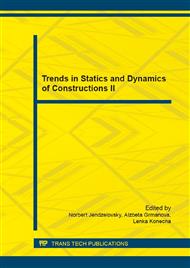p.157
p.163
p.167
p.175
p.179
p.183
p.187
p.191
p.198
Reinforcement Corrosion and its Effect on Bond Behaviour
Abstract:
The corrosion of reinforcement is one of the predominant reasons for loss of reliability of reinforced concrete structures. This has an impact on safety, serviceability and durability of the structure. The corrosion of steel in concrete reduces the cross sectional area of the reinforcement and decreases the bond between reinforcement and concrete. Corrosion products have a higher volume than steel, which produces internal stresses that lead to the cracking and spalling of the concrete cover. Additionally, corrosion of steel changes the mechanical properties of reinforcement. In this paper, the relationship between crack widths and bond strength between reinforcement and concrete was investigated.
Info:
Periodical:
Pages:
179-182
Citation:
Online since:
June 2016
Authors:
Keywords:
Price:
Сopyright:
© 2016 Trans Tech Publications Ltd. All Rights Reserved
Share:
Citation:


